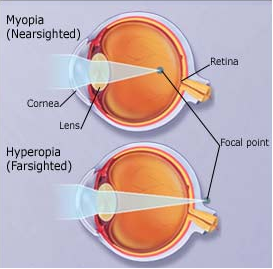Explaining Nearsighted and Farsighted
In order to see clearly, light entering the eye must be focused directly on the retina (the wallpaper on the inside back of the eye).
In nearsightedness (myopia), the light entering the eye is focused in front of the retina. Myopia can result from the entering light being bent too forcefully by the cornea and lens of the eye, or from the eyeball itself being longer than average from front to back. People with myopia can often see well close-up without glasses, but they need corrective lenses in order to see clearly in the distance.

In farsightedness (hyperopia), the light entering the eye is focused behind the retina. Hyperopia can result from the entering light being bent too weakly by the cornea and lens of the eye, or from the eyeball itself being shorter than average from front to back. People with hyperopia can (at younger ages) see clearly in the distance without glasses, but they often need corrective lenses in order to see well close-up.
If you are nearsighted or farsighted and you are tired of wearing glasses, LASIK may be an option for you! Schedule a free LASIK consultation.
Visit the American Academy of Ophthalmology’s EyeSmart® website to learn more about Nearsightedness and Farsightedness.



